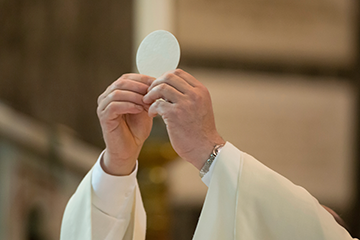 When we think of the word “adoration,” we think of a high form of love, perhaps the highest. Theologically, we equate adoration with latria, the worship and love due to God alone. In the vernacular, to say “I adore you” is to indicate an intense and high form of love.
When we think of the word “adoration,” we think of a high form of love, perhaps the highest. Theologically, we equate adoration with latria, the worship and love due to God alone. In the vernacular, to say “I adore you” is to indicate an intense and high form of love.
Liturgically, adoration of the Lord in the Blessed Sacrament indicates a period during which one enters into the experience of loving God and gazing upon Him in that love. The Lord, too, extends a gaze of love to us, as is beautifully stated in the Song of Songs: Behold, he is standing behind our wall, He is looking through the window, peering through the lattice (Song 2:9).
In all these examples there is a sort of intense, yet resting love expressed; a love that is tender and deep, quiet and fixed.
However, the greatest act of adoration the world has ever known exhibits little of this quietude or restfulness. Indeed, one might call this act of adoration quite stormy; though intense, it was not restful. In fact, you might not consider it adoration at all. But consider this reflection by Fr. Reginald Garrigou-Lagrange, O.P.:
Adoration of infinite value was offered to God by Christ in Gethsemane when he prostrated himself saying, “My Father, if it be possible, let this chalice pass from me. Nevertheless, not as I will, but as though wilt.” Christ’s adoration of the Father recognized in a practical and profound manner the sovereign excellence of God … The Savior’s adoration continued on the cross (The Three Ages of the Interior Life, Vol 2, p. 251).
At the heart of this most perfect act of adoration was obedience, a heart that not only loved God but out of that love wanted only what He wanted. True adoration of God includes both a loving acknowledgment of His excellence and a submission of our will to His in loving obedience. Out of love we offer our whole life to God.
Thus adoration is more than mere feeling, no matter how intense; it is sacrifice; it is the willing offering of one’s very self as an act of love to God, who has so loved us. No greater love is there than to lay down one’s life for God and for those we love in Him.
Is obedience and sacrifice what you and I mean when we say that we are going to Eucharistic adoration or when we say that we adore God? The most perfect act of adoration was love expressed as obedience and sacrifice.

Thank you. Thank You.
St Mark church in Westbrook, Ct. has Adoration all day Monday through Friday. I say my Breviary in the chapel there as often as possible and there seems an added dimension, especially when the St. Ligouri prayer to the Blessed Sacrament is added. Blessings to all
Dear fr. Adoration of Christ at Gethsemane was done by the Prostration of Christ.Worship and adoration is done by bowing the head , kneeling down and prostrating – all these implies our surrender before God. Like a new born child which could not do anything on its own but falling down at its mother’s feet for all its needs. In India the country of deep religious values , nobody wears a footwear inside a hindu temple, it has to be left outside the temple premises itself , even if a foreign visitor wants to visit a temple he has to remove the footwear and then can enter the temple. There they practice prostration in front of the deity , not half bending or any other gesture like that but full prostration. in Jewish culture also removing the footwear and prostration was practiced to mark Adoration. Now in most of the catholic churches nobody bothers to remove the sandals and seldom they bow and worship The Eucharist, leave alone prostration. Though it was mentioned two times in old tastament to remove the sandals at the holy place , pathetically everybody try to understand that as a symbolic text and explain that removing the sandals means that we have to remove our arrogance , pride, sin and so on in front of God, all these explanations are true, yet removing the sandals is nothing but litterally removing the sandals before entering the Altar. In India as we enter our homes we have to remove the footwear at doorsteps. Many catholic priests in India do not wear footwear while celebrating mass.Hence Adoration must be the whole expression of body,mind, soul and proper manner of adoring the holy God as shown by Christ Himself at Gethsamane.
Just wanted to say Thank you! Love my Catholic Church and so often find such negative things. This is a wonderful and pleasant surprise! Thanks so much for sharing! God bless you.